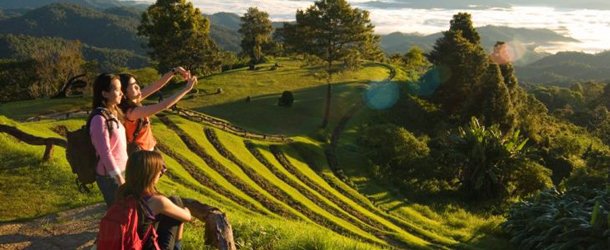Tired of watching the scenery pass you by as you ride from place to place? Consider hoofing it instead.
In Southeast Asia, you have an almost endless selection of trails to hike through, if traveling on wheels has lost its charm. Southeast Asia’s trekking trails, go through jungle, farmland, desert… even up the side of active volcanoes!
Trekking in Brunei. For Southeast Asia’s second-smallest country, Brunei sure has plenty of trekking trails – some of them winding through the region’s thickest, least exploited jungle.
Brunei’s Forestry Department cultivates several forest recreational parks, in service of a major pillar of the country’s ecotourism industry. Ulu Temburong National Park is only the biggest and most prominent of these – and how could it not be? Ulu Temburong’s long, winding jungle trails allow trekkers to climb up to the forest canopy, wade through rivers, and encounter the area’s vibrant wildlife, with an occasional friendly meeting with an Iban tribesman.
Another must-visit trekking site takes you across the sea to the Selirong Forest Recreation Park, a mangrove covered island in Brunei Bay inhabited by proboscis monkeys and migratory birds.
Trekking in Cambodia. The northern Cambodian province of Ratanakiri feels almost untouched by human hands, with more gibbons in evidence than humans. The rare northern yellow-cheeked gibbon calls Ratanakiri’s forests home; to arrange a face-to-face meeting, hit one of the trails heading through Virachey National Park that overlaps both Ratanakiri and the neighboring province of Stung Treng.
The most challenging trail through Virachey takes up to eight days to complete, and terminates at Veal Thom near the border with Laos. This patch of montane grassland shows off Virachey at its most postcard-perfect: bamboo forest layered with primal jungle, the Sesan River winding through the middle, and the mountains providing a majestic backdrop.
The gibbons aren’t the only animals in evidence; you’ll be sure to meet sambar deer, great hornbills, and if you’re lucky, the endangered gaur (wild cattle).
Trekking in Indonesia. Gunung Leuser National Park won UNESCO World Heritage Site recognition in 2004; a multi-day trek through this Sumatra natural reserve will demonstrate why it earned this honor.
Most jungle and mountain trails through and up Gunung Leuser will have you starting at Bukit Lawang, a major orangutan-spotting site. But the most challenging trail takes ten days to complete, beginning at Kedah and ending at the summit of Gunung Leuser, 3,404m above sea level.
No matter what trail you choose to explore, you’ll find yourself face to face with Sumatra’s embarrassment of wildlife riches: over 700 animal species, including elephants, siamang, and leopard cats; over 10,000 plant species, among them the world’s biggest flower Rafflesia Arnoldi.
Trekking in Myanmar. For a change of scenery, try sedate meadows and scrubs instead of thick jungle. Myanmar’s most popular trekking route – beginning at Kalaw and ending at Inle Lake – is a pleasant three-day trek through farmland, small towns, and temples, before terminating at a dock at Inle Lake’s shores.
Kalaw is a cool hill station located about 1320m above sea level. Created by the British as a temperate getaway from the lowlands’ constant heat and humidity, this colonial town is an ideal starting point for a multi-day hike. The relaxing scenery is secondary to the true charm of a Kalaw-to-Inle hike: the chance to have a genuine interaction with the many ordinary people you’ll meet along the way.







